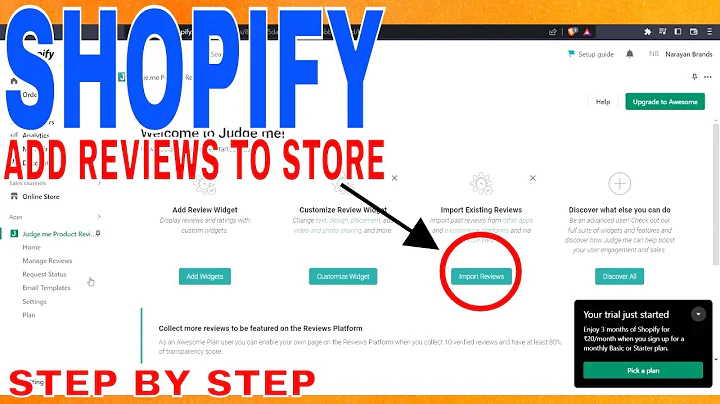Boost Conversion Rates with Shopify A/B Testing
Table of Contents:
- Introduction
- Revenue tracking challenges with Shopify
- The importance of split testing
- Case study: Dr. Axe Shopify store
4.1 Usability of the Add to Cart button
4.2 Search field optimization
- Setting up a split test in Shopify
- QA process for split tests
- Analyzing the test results
- Best practices for Shopify conversion rate optimization
- Conclusion
Article: How to Conduct Split Testing in Shopify for Conversion Rate Optimization
Introduction
In the world of e-commerce, optimizing conversion rates is crucial for the success of online stores. One effective method to achieve this is through split testing or A/B testing. Shopify, being one of the most popular e-commerce platforms, offers various tools and options to facilitate split testing. In this article, we will explore the process of setting up split tests in Shopify and discuss how it can help improve conversion rates.
Revenue tracking challenges with Shopify
Before we dive into split testing, it's essential to understand the challenges related to revenue tracking on the Shopify platform. Many marketers, designers, and agencies have faced difficulties in accurately tracking revenue due to the limitations of third-party and first-party cookies. To address this issue, Shopify has introduced a blog post on Shopfire.com, which provides insights into revenue tracking and first-party cookies.
The importance of split testing
Split testing is a powerful technique that allows store owners to systematically experiment with different elements on their website to determine the version that performs better in terms of conversion rates. By testing various elements such as button placement, color schemes, images, and product descriptions, store owners can gather data-driven insights to optimize their website for improved conversions.
Case study: Dr. Axe Shopify store
To illustrate the process of split testing in Shopify, let's take a look at a case study of the Dr. Axe online store. Dr. Axe sells natural supplementation products and serves as a great example to demonstrate split testing.
Usability of the Add to Cart button
One of the elements that can greatly impact the user experience is the placement and usability of the Add to Cart button. Some stores, like Dr. Axe, have experimented with placing the Add to Cart button below the quantity selection. This alternative placement allows users to select their desired quantity before adding the product to their cart. However, other stores, such as Amazon, prefer a more vertically aligned interaction. In our split test, we will assess the usability of the Add to Cart button placement on the Dr. Axe store.
Search field optimization
Another element that can significantly impact user experience is the search functionality. By optimizing the search field, store owners can enhance the accuracy of search inputs and provide a more streamlined shopping experience. In our split test, we will focus on testing different placeholder texts within the search field to determine if it improves the accuracy of search inputs.
Setting up a split test in Shopify
Setting up a split test in Shopify is a straightforward process. Various tools, such as Convert.com, provide a user-friendly interface to create and manage split tests. By signing up with Convert.com and accessing the experiment URL, store owners can easily set up split tests by applying pre-built CSS codes, integrating Google Analytics, and defining the variations they want to test.
QA process for split tests
Like any development or design process, it is crucial to go through a quality assurance (QA) process to ensure the functionality of the split test across different devices and screen sizes. By performing thorough QA testing, store owners can ensure that the split test functions seamlessly, providing accurate data for analysis.
Analyzing the test results
Once the split test is live, it is essential to analyze the test results to draw meaningful conclusions. By comparing conversion rates, bounce rates, and other relevant metrics between the different variations, store owners can identify which version performs better and make data-driven optimizations.
Best practices for Shopify conversion rate optimization
Apart from split testing, there are various other best practices for optimizing conversion rates on Shopify. These include optimizing page load speed, improving website navigation, utilizing persuasive copywriting, implementing social proof elements, and incorporating upselling and cross-selling strategies.
Conclusion
In conclusion, split testing is a powerful technique that can significantly improve conversion rates on Shopify stores. By testing different elements and analyzing the results, store owners can optimize their websites for better user experience and increased sales. When conducting split tests, it is crucial to follow the QA process and utilize tools that facilitate accurate tracking of revenue and metrics. By implementing best practices for conversion rate optimization, Shopify store owners can create a compelling and profitable online shopping experience for their customers.
Highlights:
- Split testing, also known as A/B testing, is an effective method for optimizing conversion rates on Shopify.
- Revenue tracking challenges on Shopify can be addressed through the use of first-party cookies.
- The placement and usability of the Add to Cart button can have a significant impact on user experience.
- Optimizing the search field can enhance the accuracy of search inputs and improve the shopping experience.
- Setting up a split test in Shopify can be done through user-friendly tools like Convert.com.
- Thorough QA testing is crucial to ensure the functionality of the split test across different devices.
- Analyzing test results allows store owners to identify which version performs better and make data-driven optimizations.
- Best practices for Shopify conversion rate optimization include optimizing page load speed, improving website navigation, and utilizing persuasive copywriting.
- Implementing split testing and other optimization techniques can create a compelling and profitable online shopping experience on Shopify.
FAQ:
Q: How can split testing benefit my Shopify store?
A: Split testing allows you to experiment with different elements on your website to determine which versions perform better in terms of conversion rates. By optimizing your website based on the test results, you can improve the user experience and increase sales.
Q: Are there any challenges with revenue tracking on Shopify?
A: Yes, tracking revenue accurately on Shopify can be challenging due to the limitations of third-party and first-party cookies. However, Shopify provides solutions and insights on revenue tracking on their blog to help overcome this challenge.
Q: What elements should I consider testing in a split test?
A: You can test various elements such as button placement, color schemes, images, product descriptions, and search functionality. Focus on elements that directly impact user experience and conversion rates.
Q: How do I set up a split test in Shopify?
A: There are user-friendly tools like Convert.com that enable you to set up split tests in Shopify. These tools provide an interface to define variations, apply CSS codes, and track metrics for analysis.
Q: What other strategies should I consider for conversion rate optimization on Shopify?
A: Apart from split testing, you should optimize page load speed, improve website navigation, utilize persuasive copywriting, incorporate social proof elements, and implement upselling and cross-selling strategies.






















